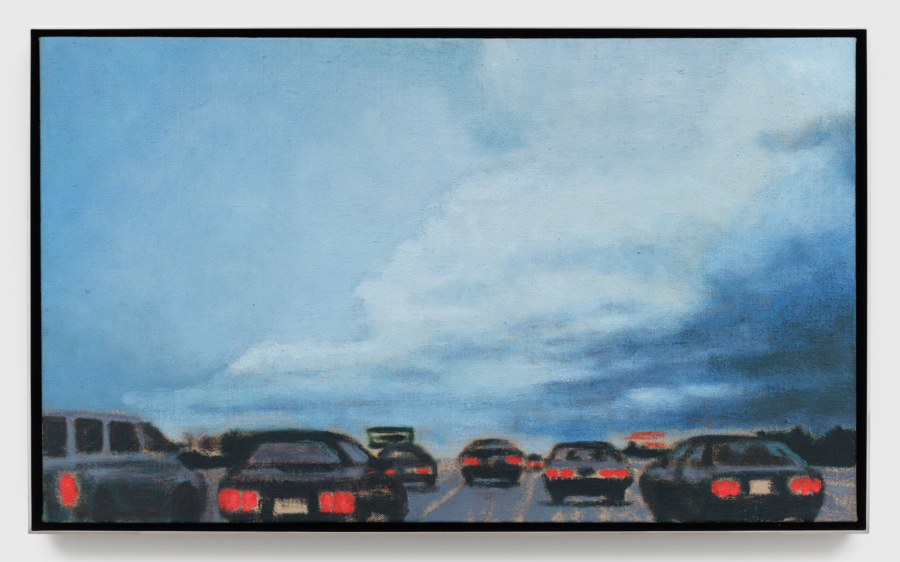October 1, 2024

Road Trip 10, 2000. Oil on linen, 16 × 27 in. (40.64 × 68.58 cm), 16 5⁄8 × 27 1⁄2 in. (42.24 × 69.85 cm) framed
Astroturf? Astroturf is synthetic grass made of vinyl and nylon used as a playing surface in sports. It is strong, rough, textured and durable. Why would an artist use it as a surface to paint on? Jane Dickson, who is well known for her paintings of Times Square and her explorations of “the psychogeography of American culture” began painting on non-traditional materials in the 1980s — vinyl, sandpaper and then astroturf — to give her surfaces a gritty, textured and impressionistic aura. This was well suited to the depiction of illuminated neon signs and nighttime rendezvous.
At Karma, a selection of older (as well as larger, more recent) landscape paintings are on view. Encircling the south gallery are fifteen small-scale framed oil on linen landscapes, all titled Road Trip and dated between 1999 and 2001. In each of these works painted from her original photographs, Dickson captures the open road as seen from behind the wheel.
The exhibition title Are We There Yet? references the desire to get to one’s destination and suggests the experience of driving there is just a means to an end. Dickson transforms moments from these journeys into paint in a quasi-realistic manner. In Road Trip 8 (2000), a light blue rectangle representing the sky, sits above three triangular shapes; two are brownish green and depict the color of the grasslands along the road. The third triangle delineates grayish brown pavement dotted with yellow stripes that vanishes into the distance. Some of the pictures are urban — containing overpasses and signs, while others capture distant hills and winding freeways.
In many, including Road Trip 10 (2000), the illuminated taillights of cars ahead document the flow (or standstill) of traffic. What stands out when seeing the paintings together is the presence and position of the horizon line that physically and metaphorically divides the paintings by emphasizing the contrast between the natural and the built environment. Often sketchily painted, these works serve as impressions and reminders of Dickson’s road trips and the wonders of travel. Although the original photographs were taken in the 1990s and the paintings created long after the photographs were shot, the images still resonate today as reminders of what has – and has not – changed specifically with respect to traveling along California‘s roadways.
In the north gallery are more recent larger works painted on Dickson’s chosen ground — astroturf. In a conversation with this writer, Dickson spoke about the process of painting on this surface, how astroturf has changed and the different ways she has learned to apply the paint (first oil now acrylic), to maximize the contrast between light and dark and to allow the textured surface to assert its own presence both formally and conceptually.
Dickson’s large paintings are most impressive, atmospheric and luscious. Though they depict scenes from the past culled from her own photographic archive, they most definitely represent the now. It is difficult to look at Out of Here North 3 (2013) and not be reminded of the devastation of the recent fires in the Los Angeles area. In this painting, a glowing orange sunset dominates the composition. In the foreground, cars with red taillights recede down a highway toward towering power lines suspended across transmission towers, a dark silhouette against the vibrant sky.
Out of Here Red Taillights Snow (2002-2013) is a dizzying and dazzling composition. A deep blue ground (the night sky) is covered with swirling red and white brush strokes — like enlarged pointillist marks — filling the frame with illuminated snowflakes refracting the red taillights. This burst of color dominates the viewer’s field of vision causing a sense of vertigo. That the ground is astroturf exaggerates the blur. Dickson’s mastery of this generic industrial material allows her to transform the ordinary into something sublime.
In more recent paintings, including El Niño Monte Vista 4, Smog Check, and North State Rainy Parking Lot (2024), Dickson continues to mine old photographs. These haunting large-scale paintings entangle the viewer into a dialectic between reality and representation. It is hard not to look at the blowing palm trees in both Smog Check and El Niño Monte Vista 4 and think about the dangers of climate change, or the fact that too much rain leads to floods as suggested in her eerie depiction North State Rainy Parking Lot.
In these paintings, Dickson focuses on the climate of Los Angeles. Although she begins with photographs shot years ago, her depictions of blowing palm trees, fire-filled skies, vintage cars and receding roadways capture today’s landscape. Dickson’s use of astroturf in the larger works calls attention to what is unsettling and unfamiliar, but as the anomaly of astroturf disappears, viewers are left with expansive, moody and disquieting paintings that speak to the ever changing now.



